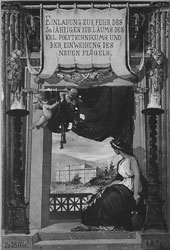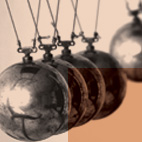|

In 1876 the Polytechnical School was relieved of the two preparatory mathematics classes in the junior section and thus of the last vestiges of school teaching. In turn, an entrance requirement for attending the polytechnic was introduced – the successful completion of a senior secondary school education, which had been increased to a total of nine years shortly beforehand – in line with the Abitur, the grammar school leaving exam, being a requirement to attend university. This parallel is by no means a coincidence: the former Vocational School, now known by its short title of Polytechnic, was now defined for the first time as "a college of technology".
Its new status sealed, the college commemorated its 50th anniversary in 1879 with a festive celebration over several days and with the inauguration of a new building. Yet behind the scenes gloomy developments were in store. In the wake of a recession, the number of students fell by half between 1876 and 1888, and the state parliament made hefty funding cuts. So these were difficult times for the Polytechnic. Despite this, new subjects were introduced, the first being Electrical Engineering in 1883. From the 1880s onwards Carl Bach managed, thanks to his great ingenuity and perseverance, to gradually establish a materials testing institute and an engineering laboratory. These were used for studying construction materials and machinery, especially steam engines.
The systematic laboratory-based study of materials and machinery marks an important milestone in the history of technology. This is the era when engineering is seen to have become a science, with engineers adapting their methods of analysis to those of the empirical natural sciences. From the outset, the fledgling discipline of electrical engineering had close links with physics and thus a highly theoretical and systematic approach, allowing it to smoothly fit in with other science-based technical disciplines. Yet as engineering subjects became increasingly scientific in nature, calls for them to be placed on a par with the other scientific disciplines also became more vociferous.
| 1839 - 1883 |
Hermann Fehling
Senior teacher of Chemistry and Technology – Professor from 1867 onwards |
| 1869 - 1877 |
Friedrich Theodor Vischer
Professor of German Literature and Aesthetics |
| 1876 |
Name changed to Polytechnic
Moves closer to university status by abolishing the two mathematics pre-school classes and introducing a new entrance qualification (secondary school leaving examination is required) |
| 1878 - 1922 |
Carl Julius (von) Bach
Professor of Mechanical Engineering |
| 1879 |
50th Anniversary
Six-day celebration, inauguration of a new building |
| 1882 |
Electrical Engineering Section established |
| 1882 |
First large-scale acquisition of third-party funding
Establishment of the Materials Testing Institute with the help of a donation of 10,000 marks from the surplus from the State Trade Exhibition |
| 1884 - 1899 |
Expansion of general subjects
In the wake of the recession, a two-year course for candidates from the higher ranks of the railway, post and telegraph services is founded to fill lecture theatres; introduction of courses in Economics and Law |
| 1885 |
Post-Doctoral Examination Regulations Enacted |
| 1890 |
Renamed Stuttgart Royal College of Technology |
 |
 |
|
 |
